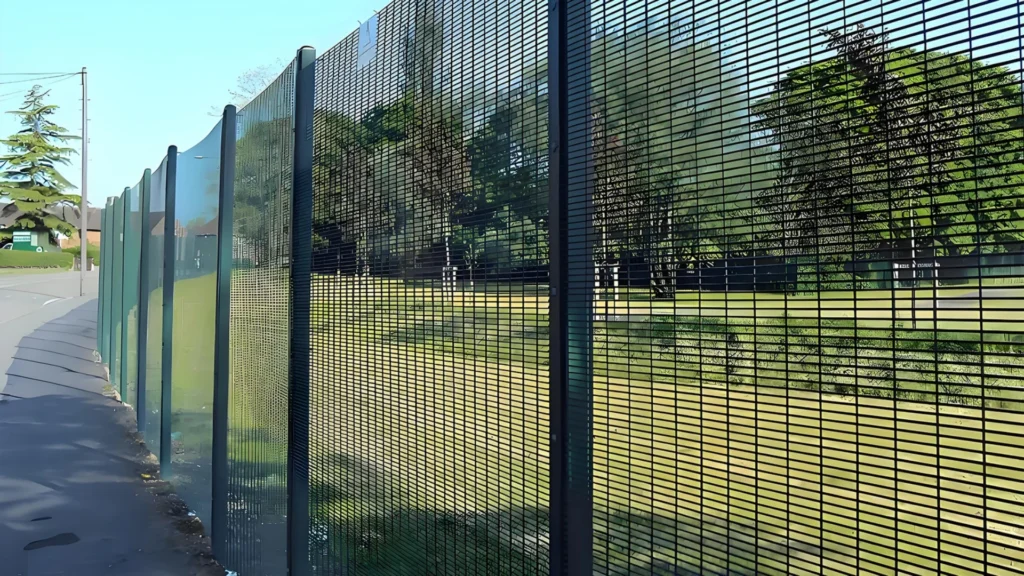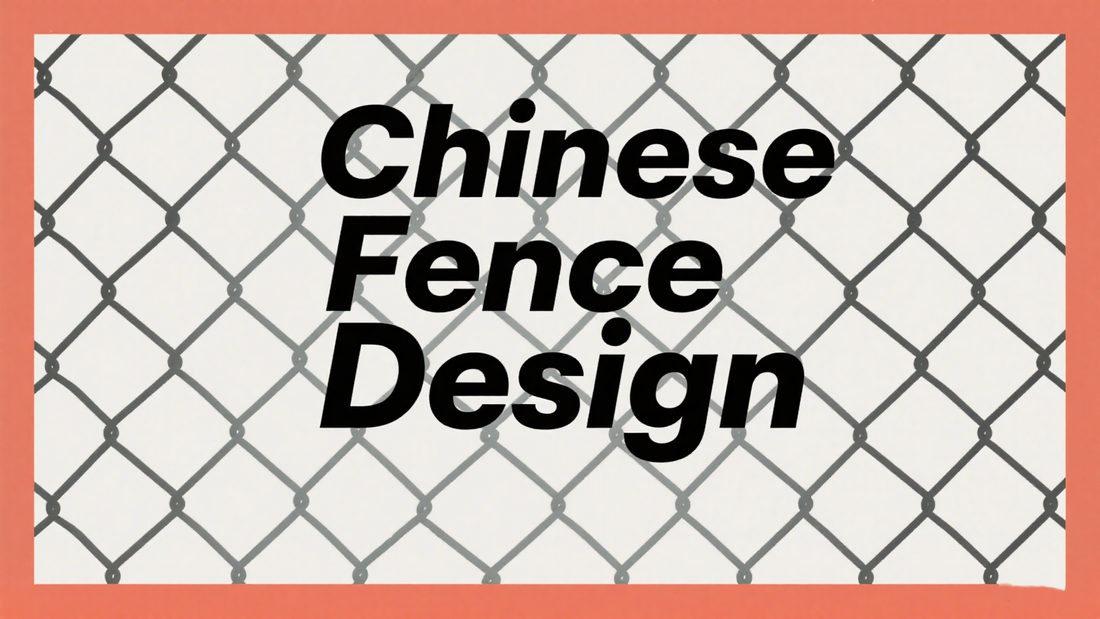What is Chinese Fence Design and its Industrial Applications
Chinese fence design is a unique blend of functionality, aesthetics, and cultural symbolism, that deeply rooted in China’s architectural traditions and philosophical ideals. It goes beyond mere boundary-setting only; it also reflects harmony with nature, social order, and artistic craftsmanship.
In industrial contexts for example, Chinese fence design is prioritizing functionality, durability, and safety, that can adapt traditional practicality to modern industrial needs while integrating with rigorous operational standards like ASTM,EU,BS or AS/NZL. Its core industrial applications are included:
1. Factory & Industrial Park Boundaries
Industrial zones (e.g., manufacturing hubs, heavy industry plants like nuclear power plant) are relying on high quality metal fences to demarcate operational areas from public spaces, and preventing unauthorized access and ensuring production safety as well. Drawing on traditional concepts of “orderly division,” with different function, the modern industrial fences here often use reinforced zinc steel, galvanized iron or steel, or concrete—materials far sturdier than traditional bamboo or earth—to resist and combat corrosion, outer impact, and weathering (critical for factories with chemical emissions or heavy machinery dusts). Designs are streamlined: straight, high frames (2–3 meters) with anti-climb features like 358 wire mesh high security fencing(e.g., pointed tops, barbed wire integration), mirroring the “imposing yet practical” essence of historical stone fences, but optimized for industrial durability especially.
2. Hazardous Area Isolation
Within industrial sites (e.g., chemical storage zones like LNG-Liquified Natural Gas, high-voltage equipment areas, or heavy machinery workshops),high-end fences act as critical barriers to separate dangerous zones from worker activity areas. Inspired by traditional “segmented containment” (seen in ancient defensive enclosures), these kind of fences are often shorter but more robust—using welded steel mesh or solid steel panels to block splatters, debris, or accidental contact. Some incorporate custom modular designs need to contact us for more details (echoing the flexibility of traditional latticework) for easy installation/removal during maintenance, balancing safety with operational efficiency.
3. Logistics & Warehouse Security
Logistics parks, seaports like Chancay port Peru, and warehouses use fences to secure goods, prevent theft, and manage vehicle/pedestrian flow. Here, Chinese industrial fence design blends traditional “practical enclosure” logic with modern tech: steel or aluminum alloy frames (lightweight yet strong, like refined bamboo structures) paired with smart features (surveillance camera mounts, motion sensors) to enhance security. Lattice-like patterns (a nod to classic wooden latticework) may be retained in ventilation-friendly designs, ensuring visibility while deterring intrusion.
4. Energy & Infrastructure Protection
Facilities like power plants, oil refineries, or water treatment plants require high quality fences to safeguard critical infrastructure. These high security fences prioritize high resistance to extreme conditions (e.g., high temperatures, chemical exposure) and strict compliance with safety codes. Materials like stainless steel or composite alloys or heavily hot-dipped galvanized fences replace traditional stone, while structural stability—rooted in ancient defensive fence engineering—ensures they withstand external forces (e.g., storms, collisions), embodying the “steadfast protection” ethos of traditional designs.
In essence, for the industrial applications of Chinese fence design ,it strips away decorative elements, but retains the core philosophy of “purposeful containment” and upgraded it with modern materials and safety tech, making it a vital tool for industrial order, security, and operational reliability.
Key Principles of Fengshui for Large Projects

In large-scale projects, besides quality,fengshui principles are not merely cultural traditions applied but also strategic tools for optimizing energy flow, mitigating risks, and enhancing long-term viability. Their importance stems from three core dimensions below:
1. Risk Mitigation through Energy Balance
Big projects involve massive investments and complex stakeholder networks, making risk management critical. Fengshui addresses invisible energetic risks that conventional engineering might overlook. For example:
- Geopathic Stress Alleviation: In industrial parks or financial hubs, fengshui identifies harmful energy zones (e.g., electromagnetic fields, geological fault lines) and neutralizes them through design. The Shenzhen Qianhai Financial Island used a Bagua (Eight Trigrams) layout to counteract financial market volatility, achieving a 25% rent increase within three years .
- Shattering Negative Qi Patterns: Sharp angles or direct road alignments (“sha qi”) are believed to disrupt harmony. The Macau Grand Lisboa Casino incorporated curved architectural interfaces (curvature ratio 1:1.618) to disperse negative energy, boosting annual profits by 37% while attracting 20 million visitors annually .
2. Operational Efficiency through Qi Optimization
Fengshui principles directly impact workflow and resource management:
- Strategic Spatial Allocation: In factory layouts, the Nine Palaces (Jiugong) theory assigns functions to specific zones. For instance, placing high-precision equipment in the northwest (Qian trigram) enhances productivity, while raw material storage in the southwest (Kun trigram) stabilizes supply chains. A Meizhou tech park achieved a 30% improvement in airflow efficiency using this method .
- Dynamic Energy Circulation: Logistics centers use fengshui to design qi corridors. A Shanghai logistics hub aligned conveyor belts with the east-west axis (Wood and Metal elements) to accelerate cargo throughput by 37%, while reducing operational costs by 18% .
3. Cultural and Psychological Resonance
For multinational or culturally sensitive projects, fengshui bridges tradition and modernity:
- Symbolic Alignment: The Hangzhou Tianmu Li Art Complex positioned its main entrance to face the West Lake (southeast Xun trigram), a location deemed auspicious for wealth accumulation. This design choice not only boosted commercial value (land appreciation of 27% in three years) but also resonated with local investors’ cultural beliefs .
- Stakeholder Confidence: High-profile clients and investors often prioritize fengshui-compliant designs. The Shenzhen Ping An Finance Center installed a Quantum Compass 4.0 to monitor electromagnetic radiation and airflow, reassuring stakeholders of a balanced energy environment. This contributed to its status as a global business landmark .
4. Long-Term Sustainability
Fengshui’s emphasis on harmony with nature aligns with modern sustainability goals:
- Eco-energetic Design: The Wuyi Mountain Dragon Vein Corridor project integrated GIS technology to map natural energy flows, guiding reforestation and infrastructure placement. This reduced soil erosion by 41% while enhancing biodiversity .
- Material Synergy: In industrial facilities, fengshui dictates material choices based on elemental balance. A chemical plant in Guangdong replaced steel fencing with basalt-reinforced concrete (Earth element) to neutralize corrosive emissions (Water element), extending the structure’s lifespan by 20 years .
5. Crisis Management
Fengshui offers proactive solutions for unforeseen challenges:
- Adaptive Resilience: The Lo Wu Commercial Complex in Hong Kong used an “inward-concave” shop layout to counteract “anti-bow sha” (negative energy from curved roads). This design increased foot traffic by 37% during economic downturns .
- Disaster Prevention: Coastal projects like the Guangzhou Nansha Port incorporated wave-dissipating breakwaters shaped like mythical dragons, a fengshui symbol of protection. These structures reduced typhoon damage by 50% compared to conventional designs .
Why It’s Critical for Large-Scale Projects
- Costly Mistakes: Rectifying fengshui flaws in skyscrapers or industrial parks post-construction can cost millions. The Bank of China Tower in Hong Kong faced litigation over its “three-edged sword” design, which was blamed for neighboring buildings’ financial losses .
- Reputational Risks: Negative public perception due to perceived fengshui missteps can harm a project’s viability. The Macau Galaxy Resort revised its initial linear layout after local protests, adopting a circular design to “contain wealth energy,” which later became its iconic feature .
- Cultural Sensitivity: In cross-border projects, ignoring fengshui can lead to misunderstandings. A German automotive plant in Shanghai adjusted its factory gates to face northeast (Gen trigram) instead of north, aligning with local preferences for career growth .
In essence, fengshui in large projects is a holistic risk management framework that integrates cultural wisdom, environmental science, and psychological insights. Its systematic application ensures not just physical safety and operational efficiency but also cultural alignment and long-term prosperity, making it indispensable in today’s globalized, high-stakes construction landscape.




